April 30, 2020
By Călin Boto
To Investigate, To Instruct
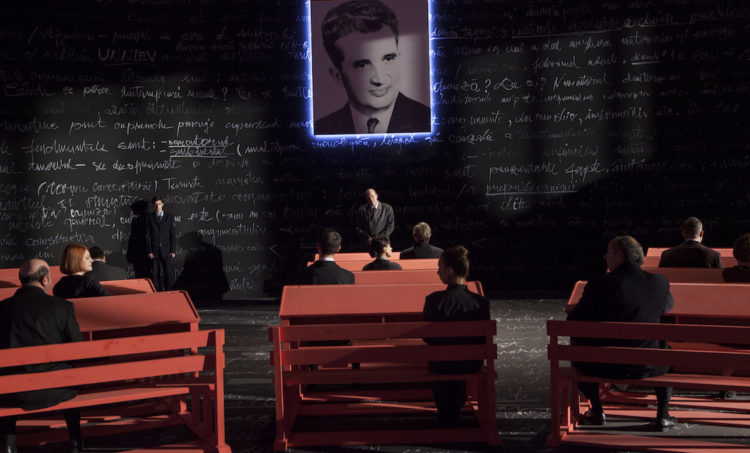
Uppercase Print
Radu Jude seems to be running a marathon: his last eight movies (the well-known Aferim!, Scarred Hearts, The Dead Nation, and I Do Not Care If We Go Down in History as Barbarians, the more recent Uppercase Print and The Exit of the Trains, together with the two shorts The Marshal’s Two Executions and To Discipline, To Punish, all completed in only five years[1]) fast-forward through histories, canons, and traditions, recuperating and, most prominently, advancing transgressive film ideas and practices.
If the first fifteen years of the Romanian New Wave have firmly established the practice of representing a “slice of life,” with notable successes, Jude comes to contest the entire medium of film, judging it as deceptive: less a window overlooking “reality” and more like a telescope that someone, somewhere, has carefully adjusted and directed. Radu Jude likes to whistle. This is not the kind of whistling betraying nonchalance, but more like a whistle within a church: loud, subversive, irreconcilable; a display of bravado. His films instruct (the audience) and investigate (history, theory, narratives, practices, traditions). His is an engaged work that, at times, attempt to deliver for justice and keeps itself provocative in both content and form.
His contentious, anti-illusionary attitude stems from the tradition of oppositional theater and film (or non-Aristotelian, epic, or dialectical theater, as Bertold Brecht called it, or counter-cinema, as referred to by Peter Wollen), both outright left-wing in their vision.
The first of these, radical modernism,[2] was pioneered in the field of theater by Brecht (following Erwin Piscator), who developed theoretical and practical innovations over a period of almost three decades. Brecht’s theater declared itself scientific (within the humanities, especially sociology), the only kind that could satisfy an audience of the age of science. Brecht sought an active receiver in the viewer, one that would not let themselves carried away by the show’s narrative and would not empathize with the characters (this kind of empathy he termed Einfühlung – which can be translated into English as intropathy –, a concept from 20th century German aesthetics; what he was aiming to create therefore was a non-intropathic theater), but would understand them at an informational level. The Brechtian actor mediates knowledge, not feelings, through a kind of acting that refuses ornamentation (vocal inflections, gestures, emphases, all of these are reduced to a minimum). Brecht calls his theater non-Aristotelian because it lacks catharsis.
But cinema requires a medium-specific anti-illusionism. The political modernism of the ’60s and ’70s started from Brecht but then branched out in the works of very different filmmakers from various parts of the world: Jean Luc Godard and Jean-Pierre Gorin in France, Dušan Makavejev in Yugoslavia, Jean Marie Straub, Danièle Huillet, Alexander Kluge, Rosa von Praunheim, and the younger Harun Farocki and Hartmut Bitomsky in West Germany, Miklós Jancsó in Hungary, Theo Angelopoulos in Greece, Fernando Solanas and Octavio Getino in Argentina, and Laura Mulvey and Peter Wollen in the UK. This is indeed a fascinating cast, a group whose work embodies both the high points of the ’60s and ’70s as well as the hermetic rigidity of film theory (and Grand theory in general) at the time, whose main sources were western publications like Cahiers du cinéma, October, New Left Review, Screen, and the more bourgeois Artforum.
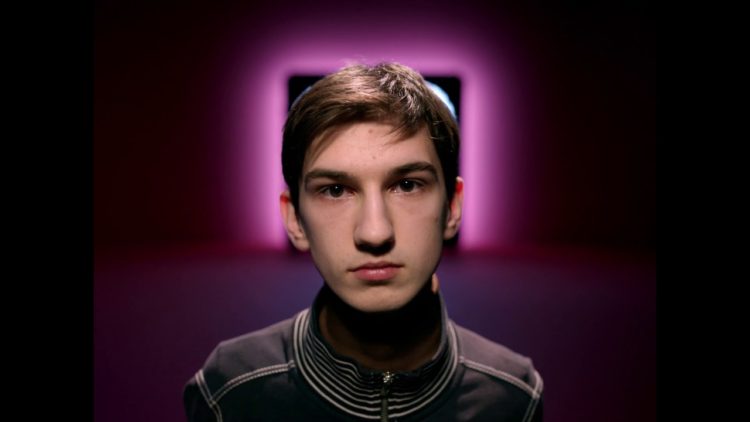
Uppercase Print
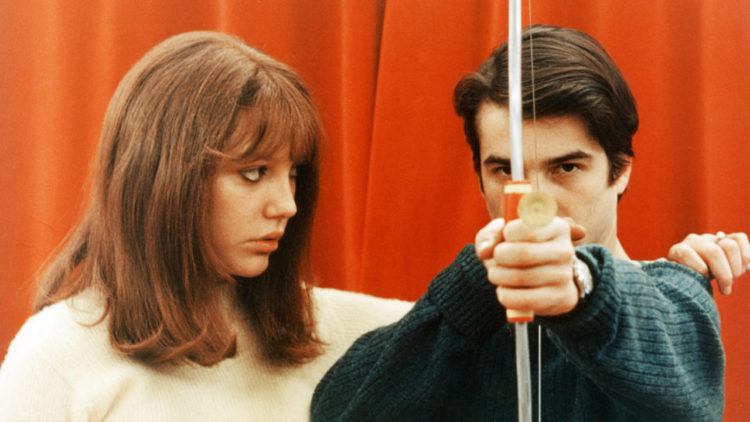
La Chinoise (d. Jean Luc Godard, 1967)
What they all got from Brecht varies, but the general thread is the desire to establish a cinema hostile towards mass production (often barbarized in order to serve the need of this counter-cinema), that would create a critical viewer (an active receptor à la Brecht), critical regarding both what cinema is (an illusion, and illusions cannot be ideologically neutral, only normalized through standardization) and what lies beyond it (an industry and, implicitly, an ideology). Some created an austere and rigorously formal cinema (Straub-Huillet) while others borrowed from the iconography of mainstream cinema (Godard). Some enacted the old Brechtian dream of representing class dynamics in their stories (Makavejev, Straub-Huillet) while others enacted more specific formal and political dreams (Farocki and the critique of the Vietnam War, Mulvey-Wollen and a cinema opposed to the male gaze, and von Praunheim and the emancipation of gay men). In time, most anti-illusionist tendencies became associated with Brecht, perhaps too many. It should be noted that there is another anti-illusionist tradition in ’60s and ’70 cinema, namely structural film. It was apolitical by default and associated with three cooperatives of experimental filmmakers in New York (The Film-Makers’ Cooperative), California (Canyon Cinema), and London (London Film-Makers’ Co-op).
Even though Brecht, like Eisenstein, was frequently translated and discussed in Socialist Romania, it was only in the 2000s that his influence truly made itself felt, when a young generation of film and theater directors, writers, and actors, under the guidance of Professor Nicolae Mandea (from the National University of Theatre and Film in Bucharest), brought political theater and its mechanisms to the forefront. Among them are David Schwartz, Mihaela Michailov, Paul Dunca, Mihaela Drăgan, Gianina Cărbunariu, Ioana Păun, and Bogdan Georgescu.
The communist regime, on the other hand, was not so open to the agenda of political modernism. Apart from a few movies by Miklós Jancsó and Jean-Luc Godard (pre-’68), the innovations of this new left-wing cinema were completely silenced in Romania in the sixties and seventies.[3] Given this lack of a precedent, it is no surprise that the recuperation of political modernism was slow. The first steps taken towards this were made between 2010 and 2015, with the student film magazine Film Menu, supervised at the time by Andrei Rus, which published essays discussing films by directors like Straub, Huillet, Jancsó, and Makavejev, with related film screenings at the magazine’s film club. Another relevant event from this period was the release of the movie Aferim! and of Andrei Gorzo’s book Imagini încadrate în istorie. Secolul lui Miklós Jancsó [Images Framed in History. The Century of Miklós Jancsó], both in 2015. Also important was the publication of Gorzo’s book Lucruri care nu pot fi spuse altfel [Things That Cannot Be Said Otherwise] (2012), the first serious Romanian study tracing the history of the concepts of realism and anti-illusionism in film.
Starting with Aferim!, Jude’s anti-illusionist practice assumes multiple forms, ranging from inserts of recognizable quotes (in Aferim!, for instance) to breaking the narrative to showcase the document it is an adaptation of (in Scarred Hearts) or the use of inherently performative documents, that is, whose discourse is anchored both in fiction and in reality (the portraits from the Costică Acsinte archive used in The Dead Nation and To Discipline, To Punish). Everything – theater, history, literature, photography – including film, which is the medium through which Jude showcases this fact, mediates reality. But make no mistake: Jude is not living the dream of cinema as syncretic art that absorbs and neutralizes all influence from other media. On the contrary, he offers a geography, a topography of cinema, where reality is the unreachable peak, and then, as we descend in altitude, the traces of reality increasingly fade out and the information becomes increasingly more mediated. Some of his films adopt an overview – first there is something approaching this peak, perhaps something small and personal, such as a diary (Emil Dorian’s in The Dead Nation and Grigore Lăcusteanu’s in To Discipline, To Punish), then something of medium intensity, like official photographs (family or military, individual or group portraits, where the social performance somewhat compromises their value as slices of life), and, next to them, something low, mediated, like fragments from propaganda songs. Jude’s fiction abounds in non-fiction, as non-fiction abounds in fiction.
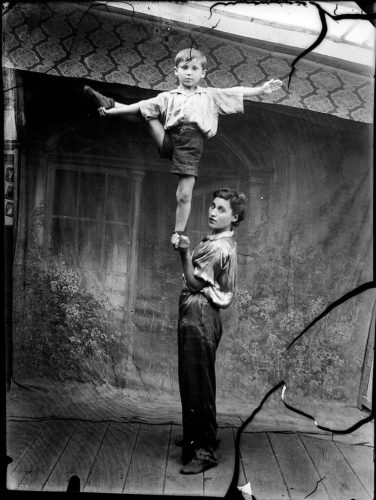
Dead Nation
How should we approach Jude’s most recent film, Uppercase Print, which has just had its premiere? It seems impossible to grasp. We would be hard-pressed to find it a worthy precursor in the “official” Romanian cinema. Perhaps it will have a follower. However, in unofficial cinema – that cinema that is only distributed, watched, and discussed in more esoteric settings – there is something: a shot recorded by journalist Paul Cozighian, one of the first recordings of the ’89 revolution. The camera follows the television broadcast of Nicolae Ceaușescu’s famous December 21 speech when, suddenly, Cozighian draws the viewer’s attention towards the window, where we can see groups of people leaving while the speech goes on. Image and counter-image; illusion and non-illusion.[4] And, even though it’s been a long time and my memory might be playing tricks on me, I remember a similar thing happening in a short film by Ion Grigorescu, namely My Beloved Bucharest (1977), where the shots of construction sites from the edge of town are interposed with headlines announcing celebrations. Again, image and counter-image; illusion and non-illusion; communism and a different kind of communism, but in fact the same. They are articulated in a similar way to how Jude does it in Uppercase Print.
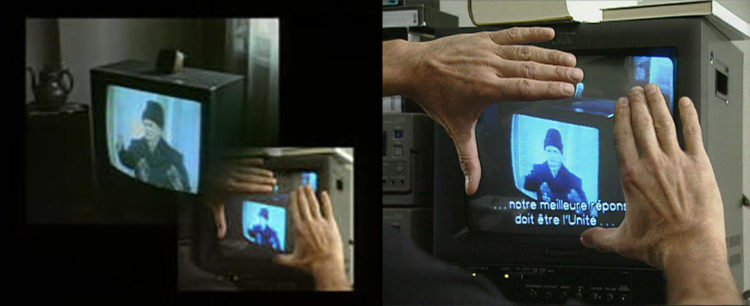
Interface (1993, d. Harun Farocki)
Uppercase Print consistently follows an Eisensteinian principle that Jude synthesized and popularized in the interviews before the film’s premiere at the Berlinale: “. . . basically, the idea is that juxtaposing two images by means of montage may produce a third image in the mind of the viewer, whose meaning lies precisely in the juxtaposition of the two images. It does not exist on its own in either of the two taken separately, but only put together.”[5] This kind of popularization of film theories is valuable, especially given that his status as prize winner, as well as other advertising constructs of the film industry, give Jude a platform that a film critic or theorist could only dream of. If Jude’s films feel somewhat hermetic, that is also because the local audience and film press have had very little contact with the tradition he is working in.
There are two groups of images that Jude juxtaposes to get the desired effect – directed scenes adapted from Gianina Cărbunariu’s play Tipografic Majuscul and a large quantity of material from the TVR (Romanian Television) archive broadcast at the time (the early ’80s).
The subject of the show and of the movie is Mugur Călinescu, a boy from Botoșani who, inspired by Radio Free Europe, wrote anti-regime slogans on the walls of local buildings, protesting the curtailing of democracy under the Ceaușescu regime, the lack of free unions, and the shortage of food. Today he is a forgotten dissident whose case reemerged sporadically in the press and who at the time was only whispered about. The Securitate’s detailed, schizo-paranoid investigation produced two files: the Billboard (Panoul), an investigation put together before catching Călinescu in the act, and the Student (Elevul), his surveillance file. It is these documents that Cărbunariu took as her starting point in writing her play.[6] They consist of testimonies, reports, transcripts of conversations between Călinescu and his mother, Rodica Uncescu, captured on microphones hidden in their home. All of these were corroborated with interviews with the officers handling the case, done by historians Mihail Bumbeș and Mihai Burcea. The texts were modified, spliced, and edited so that the work would straddle fiction and documentary at the same time.
This is where Jude enters the scene. Together with Cărbunariu he adapted the play into his script, to which he adds the anti-illusionist techniques developed in his last films – Eisensteinian montage, blurred boundaries between regular lines and quotes (unlike in Aferim! or “I Do Not Care If We Go Down in History as Barbarians,” the implicit challenge is no longer to identify the lines which are quotes, but those which are not, which keep everything else together), fluid transitions between very different audio-visual material, etc.
Let us look at these two approaches in order.
The first, Jude’s reenactment, is a visual paradox – garish colors, minimal but over-the-top props (a cardboard TV set, an oversized tape recorder, a giant blackboard). In spite of all this, it is an austere film: nothing surrounds the subject, often placed in the center, and the Brechtian acting with its gestures reduced to a minimum makes the space seem even larger, emptier. The camera often assumes the point of view of the investigator: most of the testimony sections are answers given to an interrogator. This is how Jude, in a documentary style, constructructs his narrative: in fragments, like a detective’s case, showing testimony after testimony, systematically representing all the inconsistencies of the Securitate, but also of the local community. The sensitive points of the film are the testimonies of Mugur Călinescu’s friends, children entrenched without consent into the ’80s system of paranoia. There are no heroes in Jude’s film, no characters who change history, only characters trapped in it.
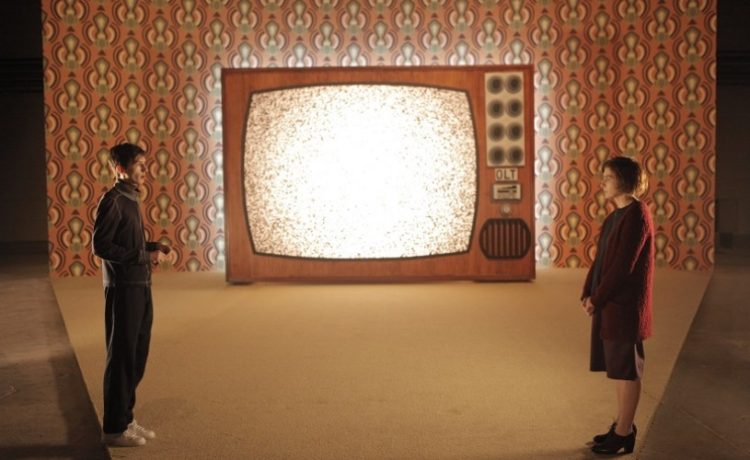
Uppercase Print
The role of the camera, the nature of the documents, but also the information given through dialogue (Călinescu is aware of the microphones in his house) taint the film with a sense of paranoid schizophrenia, putting the viewer in a position of perverse complicity: we witness the violation of any right of privacy from the other side of the screen and of history, where it is warmer and better. Knowing the sources of the information, the viewer tends to downplay the fictional interventions of Jude and Cărbunariu – the dialogue could have been recorded by the Securitate, the teachers’ meeting at Călinescu’s high school might have been based on an informer’s description, and the telephone conversations could have been tapped. Mugur Călinescu is played by the young Șerban Lazarovici, and the film showcases actors Jude collaborated with in the past – Ioana Iacob, Șerban Pavlu, Gabriel Spahiu, and Ilinca Hărnuț. All of them follow a Brechtian method, with minor deviations. The actors appear, say their lines, and disappear. This is, paradoxically, the non-illusion that Jude generates.
The illusion lies in the televised footage from between 1981 and 1984. At a first glance, the material seems varied – television investigations on drivers from Bucharest, various kitschy and festive choreographies showing “Romanians everywhere” (that is, with different outfits: civilians, physicians, soldiers, children, etc.) locked in folk dance, scenes from televised plays, entertainment shows, etc. There are also exceptions: neutral, pale news coverage that has aged somewhat better, but this is rarely shown. Although all of this material has documentary value, its role in Jude’s film is to document the illusion of prosperity in a nation in full moral and economic decline. It is a non-illusion (as they are historical documents) that attest to an illusion. Uppercase Print was called an essay film. In this (dilettante) logic, let us look at the thesis that Jude puts forth by means of montage, as it is clear that the two types of filmic material do not have anything essayistic in themselves. That can only result from the dialectics of montage. So:
Image + counter-image = dissonance
Image + counter-image = dissonance
Image + counter-image = dissonance
And so on. A weak thesis for any kind of essay, literary or academic, written or filmed. And this is one of the film’s two big problems: redundancy, which can either serve a didactic purpose (repeating the same insights obtained through montage for two hours in order to firmly plant them in the viewer’s mind), or a punitive, i.e. superfluous, one. Here we have a bit of both, but it is worth questioning whether one doesn’t cancel the other out. Furthermore, how much space for critical reflection does a viewer have in such a closed work? The film also comes with two addenda: adaptations of interviews with the members of the Securitate that worked on the Călinescu case and a documentary section filmed around the People’s Salvation Cathedral. Critical reflection? More like well-trodden paths: the mysterious, contradictory, rotten aura of the former Securitate and the cacophonies of the present.
The second problem is that Jude’s anti-illusionist credo is inconsistently applied. If in the directed part we see a self-referential film, this changes when Jude becomes the mediator between the TVR archive and the viewer. Here he answers to nobody, becomes nonchalant and obscure; now is our chance to see “History.” This can be discussed theoretically (a deontology of archive footage?) and applied: it is the Einsensteinian effect that makes us sensitive to this obscure selection, that is, if we see it relative to the other, transparent, material. Let us try a new formula:
Anti-illusionist approach + illusionist approach = dissonance
Anti-illusionist approach + illusionist approach = dissonance
Anti-illusionist approach + illusionist approach = dissonance
And so on.
I recall an interview where Jude quoted Jonas Mekas, saying that everything must be stored in film archives.[7] Indeed, everything must be stored, but not everything can be shown. We need selections and, more than ever, we need a transparent process of selection, and what better way of achieving this than through an updated political modernism?[8] Jude’s selection is presented as is, in mostly chronological order.[9] Okay, but how do the selected materials justify their supposed status as symptoms? Of course, they serve the director’s intent and can produce an ironic effect. They easily gain a macabre aura when juxtaposed with the Călinescu case. But couldn’t this process work just as well with footage from any decade after the ’50s, with its images, abuses, and illusions? Indeed it could, asserts Jude through his second addendum: we find illusions everywhere nowadays, on the street, in ads, or in buildings built on illusions, like the Cathedral. So, when it comes to television, why is it the most relevant for audio-visual production in the early ’80s? Why not Sahia Film’s productions? Or the feature films shown in cinemas? Or bootleg VHS tapes? I do not wish to relativize, I do realize that television was the most popular medium, but the problem is still there: half of Uppercase Print is well-anchored in the ground, while the other is in the air.
[1] I realize that focusing solely on the last five years is a questionable choice and that Jude made relevant work before 2015, too. However, his work from between 2006 and 2014 does not relate to my goals with this essay.
[2] In James Naremore’s terminology in Acting in the Cinema, 1988, p. 3. One should also mention that Peter Wollen viewed Brecht’s practice as moderate relative to other movements and artists of the time, which he considered truly radical, like Meyerhold, Artaud, and Bauhaus theater.
[3] Political modernism seems to also be absent from the period’s underground distribution of VHS tapes. Even though I have read and been told about how bootleg copies of films by Jim Jarmush, Rainer Werner Fassbinder, and Derek Jarman would circulate, I have found nothing from the directors I mentioned before.
[4] It is not quite accurate to say that Cozighian’s recordings are obscure, given that he sold some of them to French television, as he himself has stated in multiple interviews. But, especially from the vantage point of a medium like film that is so obsessed and fascinated with the concept of authorship, these images have a low authorial value. The images remain while the name is forgotten. At its worst, contemporary cinema does the complete opposite. The way I found Cozighian’s footage was through Harun Farocki’s two films, Videograms of a Revolution (1992, in collaboration with Andrei Ujică) and Schnittstelle (1995). Filmmaker Radu Muntean talks about the value that Videograms had as far as preserving footage that would have otherwise been lost, and which he also made use of during his research for his full-length film The Paper Will Be Blue (2006).
[5] Gianina Cărbunariu, Radu Jude, “De ce am făcut ‘Tipografic majuscul’ (spectacolul & filmul),” https://www.scena9.ro/article/carbunariu-jude-tipografic-majuscul, accessed March 14, 2020.
[6] All my information about the staging of the play comes from the text written by Jude and Cărbunariu in Scena9 (quoted above), as well as from Iulia Popovici’s review. The trailer on the Odeon Theater’s YouTube page is also available, but of little help in answering the questions I had – whether Cărbunariu also made use of Brechtian acting, what the dynamic between the action on stage and the audio-visual backdrop was, whether she made use of recorded music, etc.
[7] Iulia Popovici, “Perhaps we should consider all images as being integrally fictitious, but can we?”, interview with Radu Jude, Irina Trocan; Andra Petrescu (editor), Realitatea ficțiunii, ficțiunea realului. Abordări teoretice ale documentarului [The Reality of Fiction, The Fiction of Reality. Theoretical Approaches to Documentary Film], Hecate, 2018, Bucharest, p. 138.
[8] The phrase used by Veronica Lazăr and Andrei Gorzo in their excellent essay about “I Do Not Care If We Go Down in History as Barbarians.”
[9] The interview in Scena9.
Translated by Rareș Grozea
POSTED BY
Călin Boto
Călin Boto is the editor-in-chief of the cinema magazine Film Menu and the coordinator of its weekly film club. As a freelancer, he collaborates with several publications and film festivals, includin...



